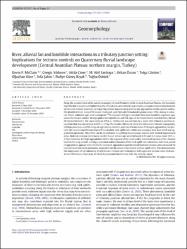| dc.contributor.author | McClain, Kevin P. | en_US |
| dc.contributor.author | Yıldırım, Cengiz | en_US |
| dc.contributor.author | Çiner, Tahsin Attila | en_US |
| dc.contributor.author | Sarıkaya, M. Akif | en_US |
| dc.contributor.author | Özcan, Orkan | en_US |
| dc.contributor.author | Görüm, Tolga | en_US |
| dc.contributor.author | Köse, Oğuzhan | en_US |
| dc.contributor.author | Şahin, Sefa | en_US |
| dc.contributor.author | Güneç Kıyak, Nafiye | en_US |
| dc.contributor.author | Öztürk, Tuğba | en_US |
| dc.date.accessioned | 2021-01-11T09:14:17Z | |
| dc.date.available | 2021-01-11T09:14:17Z | |
| dc.date.issued | 2021-03-01 | |
| dc.identifier.citation | McClain, K. P., Yıldırım, C., Çiner, T. A., Sarıkaya, M. A., Özcan, O., Görüm, T., Köse, O., Şahin, S., Güneç Kıyak, N. & Öztürk, T. (2021). River, alluvial fan and landslide interactions in a tributary junction setting: Implications for tectonic controls on Quaternary fluvial landscape development (Central Anatolian Plateau northern margin, Turkey). Geomorphology, 376, 1-21. doi:10.1016/j.geomorph.2020.107567 | en_US |
| dc.identifier.issn | 0169-555X | |
| dc.identifier.issn | 1872-695X | |
| dc.identifier.uri | https://hdl.handle.net/11729/3012 | |
| dc.identifier.uri | http://dx.doi.org/10.1016/j.geomorph.2020.107567 | |
| dc.description.abstract | Along the western flank of the northern margin (Central Pontides) of the Central Anatolian Plateau, the humidity from the Black Sea is much higher than the central and eastern flanks and creates a complex relationship between surface and tectonic processes by triggering intense mass wasting activity and aggradation within narrow valleys. We identified three incised fill terrace levels and used Optically Stimulated Luminescence (OSL) dating to calculate fluvial sediment ages and cosmogenic 36Cl exposure dating to calculate limestone boulders exposure ages across the terrace surface. Stratigraphical interpretations and OSL ages of the lowest levels revealed that a fluvial fill terrace formed in the main valley at 275.6 ± 12.8 ka and was overlain by a main river-tributary junction alluvial fan that was abandoned at 39.5 ± 3.5 ka. The results collectively show the influence of climate, topography, hillslope processes, and lithology on aggradation-incision patterns of main rivers. Prolonged aggradation can prevent the channel equilibrium required to calculate rock uplift rates while also causing a new base-level and aggradation upstream. This effect can be exacerbated in uplifting mountainous regions with limited depositional areas. Bedrock incision rates based on the fluvial terrace age were between 0.15 and 0.2 mm/a since 39.5 ± 3.5 ka. However, the high aggradation within this segment of the main valley prevented incision of the channel bedrock for long periods, causing a potential underestimation of the rock uplift rate calculation. Our local period of aggradation appears to be related to increased aggradation and decreased bedrock incision rates measured 14 km upstream that were previously assumed to be the result of decreased tectonic uplift rates. This demonstrates the importance of corroborating strath terrace incision rate estimations with ages and incision rates of downstream fill terraces, if present, to check for potential interference with the tectonic signal. | en_US |
| dc.language.iso | eng | en_US |
| dc.publisher | Elsevier B.V. | en_US |
| dc.relation.isversionof | 10.1016/j.geomorph.2020.107567 | |
| dc.rights | info:eu-repo/semantics/closedAccess | en_US |
| dc.subject | Alluvial fan | en_US |
| dc.subject | Central pontides | en_US |
| dc.subject | Cosmogenic surface exposure dating | en_US |
| dc.subject | Filyos river | en_US |
| dc.subject | Fluvial terrace | en_US |
| dc.subject | Landslide | en_US |
| dc.subject | OSL | en_US |
| dc.subject | Turkey | en_US |
| dc.subject | Fluvial geomorphology | en_US |
| dc.subject | Luminescence dating | en_US |
| dc.subject | Radiocarbon dating | en_US |
| dc.subject | River terrace | en_US |
| dc.subject | Tectonic setting | en_US |
| dc.subject | Anatolia | en_US |
| dc.subject | Pontides | en_US |
| dc.subject | Yenice river | en_US |
| dc.subject | Meleagris gallopavo | en_US |
| dc.subject | Black-Sea coast | en_US |
| dc.subject | Uplift-driven | en_US |
| dc.subject | High atlas | en_US |
| dc.subject | Climate | en_US |
| dc.subject | Deposits | en_US |
| dc.subject | Record | en_US |
| dc.subject | CL-36 | en_US |
| dc.title | River, alluvial fan and landslide interactions in a tributary junction setting: Implications for tectonic controls on Quaternary fluvial landscape development (Central Anatolian Plateau northern margin, Turkey) | en_US |
| dc.type | article | en_US |
| dc.description.version | Publisher's Version | en_US |
| dc.relation.journal | Geomorphology | en_US |
| dc.contributor.department | Işık Üniversitesi, Fen Edebiyat Fakültesi, Fizik Bölümü | en_US |
| dc.contributor.department | Işık University, Faculty of Arts and Sciences, Department of Physics | en_US |
| dc.contributor.authorID | 0000-0001-8598-8596 | |
| dc.identifier.volume | 376 | |
| dc.identifier.startpage | 1 | |
| dc.identifier.endpage | 21 | |
| dc.peerreviewed | Yes | en_US |
| dc.publicationstatus | Published | en_US |
| dc.relation.publicationcategory | Makale - Uluslararası Hakemli Dergi - Kurum Öğretim Elemanı | en_US |
| dc.contributor.institutionauthor | Öztürk, Tuğba | en_US |
| dc.relation.index | WOS | en_US |
| dc.relation.index | Scopus | en_US |
| dc.relation.index | Science Citation Index Expanded (SCI-EXPANDED) | en_US |
| dc.description.quality | Q2 | |
| dc.description.wosid | WOS:000612688200003 | |



















